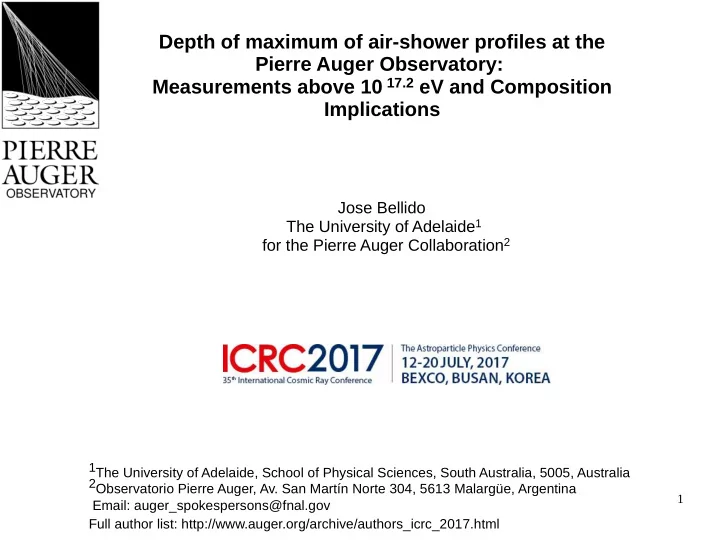

Depth of maximum of air-shower profiles at the Pierre Auger Observatory: Measurements above 10 17.2 eV and Composition Implications Jose Bellido The University of Adelaide 1 for the Pierre Auger Collaboration 2 1 The University of Adelaide, School of Physical Sciences, South Australia, 5005, Australia 2 Observatorio Pierre Auger, Av. San Martín Norte 304, 5613 Malargüe, Argentina 1 Email: auger_spokespersons@fnal.gov Full author list: http://www.auger.org/archive/authors_icrc_2017.html
FD standard telescopes (one of four FD buildings) Credit: Steven Saffi University of Adelaide 2
HEAT telescopes (in upward mode) 3
HeCo (HEAT + Coihueco) FD-standard (FOV 0º to 60º elevation) (FOV 0º to 30º elevation) 4
HeCo (HEAT + Coihueco) FD-standard HEAT CO E = 1.07 x 10 20 eV E = 4.75 x 10 17 eV 5
Event Selection Criteria 1.Good data taking periods 2.Quality selection : ● exclude events during cloudy or aerosol rich nights. ● X max needs to be within expected field of view. ● exclude events with large χ 2 in the profile fit. ● observed profile track length > 200 g/cm 2 ( applied only in FD-standard ). 3.Fiducial selection : ● (proton) trigger probability of SD station > 0.9 ● difference of proton and Iron trigger probabilities < 0.05 ● fluorescence detector FOV cuts 6
fluorescence detector FOV cuts Three types of event geometries (A, B and C) Observed X max distribution for each type of geometry FoV limit Detector location Sum of the X max distributions 7
Resolution and Systematics in the X max measurements Systematic error Resolution 8
X max moments 9
X max moments (combining HeCo and FD-standard) 10
Elongation rate Preliminary 11
lnA moments (estimated using X max moments, for the method see JCAP 1302 (026), 2013) 12
X max distributions (HeCo) 13
X max distributions (HeCo) Interpreting X max distributions with EPOS-LHC four components composition model Proton , Helium , Nitrogen and Iron Sum of four components 14
X max distributions (HeCo) Interpreting X max distributions with Sibyll2.3 four components composition model Proton , Helium , Nitrogen and Iron Sum of four components 15
X max distributions (HeCo) Interpreting X max distributions with QGSJETII-04 four components composition model Proton , Helium , Nitrogen and Iron Sum of four components 16
X max distributions (FD) 17 17
X max distributions (FD) Interpreting X max distributions with EPOS-LHC four components composition model Proton , Helium , Nitrogen and Iron 18 18 Sum of four components
X max distributions (FD) Interpreting X max distributions with Sibyll2.3 four components composition model Proton , Helium , Nitrogen and Iron 19 19 Sum of four components
X max distributions (FD) Interpreting X max distributions with QGSJETII-04 four components composition model Proton , Helium , Nitrogen and Iron 20 20 Sum of four components
Composition fractions (obtained from fits to the X max distributions) 21 21
Summary ● X max moments (free of detector effects) 10 17.2 eV - 10 19.6 eV ● D 10 = 79 ± 1 g/cm 2 / decade , E < 10 18.33± 0.02 eV ● D 10 = 26 ± 2 g/cm 2 / decade , E > 10 18.33± 0.02 eV ● Confirmation ( with more statistics ) of narrowing of σ(X max ), E > 10 18.3 eV Interpretation (model dependent) ● Moments of lnA: The absolute values depend on the model, but the trends with energy are consistent among the three models. The lightest composition is observed at around 10 18.3 eV. ● Fits to the X max distributions: ● The largest proton abundance is around 10 18.3 eV. Above this energy EPOS-LHC and SIBYLL 2.3 suggest an increasing presence of Nitrogen and QGSJETII04 suggests an increasing presence of Helium. ● Absence of Iron between 10 18 and 10 19.4 eV. ● Small p-values observed in several energy bins. 22
Backup 23
fluorescence detector FOV cuts Three types of event geometries (A, B and C) X low X low X low X up X low X up Detector location We select events with geometries such that: X low -limit and X up -limit are estimated using real data: X low < X low -limit PHYSICAL REVIEW D 90, 122005 (2014 ) 24 X up > X up -limit
X max acceptance 19.0 < lgE eV < 19.1 17.5 < lgE eV < 17.6 ● The acceptance is estimated for each energy bin using simulations. ● The FOV cuts guarantee a homogeneous acceptance between the X low -limit and the X up -limit. ● Simulations estimate the acceptance in the outer regions of the tails of the X max distribution for more 25 precise X max moments.
Effects of the improvements in the VAOD calculation (with respect ICRC15) 26
ICRC17 - statistics ICRC15 - statistics 27
28
29
Recommend
More recommend